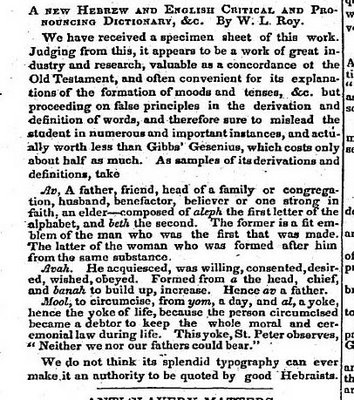Rashi script* and other Hebrew examples in Pantographia from 1799
Over at the Main Line I posted about a beautiful book called Pantographia; containing accurate copies of all the known alphabets in the world; together with an English explanation of the peculiar force or power of each letter (by Edmund Fry, London, 1799).
Great examples of many different kinds of alphabets included, with sources given. In addition, the Lord's Prayer is presented in each alphabet (and language) along with English transliteration. It is the nature of the beast that such a work would include lots of examples which look a little bit strange to the modern eye that has seen many of the actual scripts, as opposed to Western renderings of them (see, e.g.).
From his presentation of Hebrew (pp. 142-151):
1. The regular Hebrew script:

The source given for this example is Claude Duret, which is to say it is from a 16th century book.
Later an example of the modern Hebrew is given:

2. This one, also from Duret, is described "very early used by the Jewish Rabbis
in Germany, by whom it was much esteemed, as a handsome current letter, and easy to be written on account of its roundness, wherefore they generally used it in their commentaries-
and translations."
That is, it's purports to be an Ashkenazic script.**

3. This one is a Sephardic script, also from Duret, but it cites as an authority notable Hebraist Sebastian Muenster.**

4. To me this one is the most interesting. As you can see, it's the script we call Rashi script:
"The alphabet of Rabbinical Hebrew, of which there are three sizes at the Type-Street Foundery."

And a typical printed example is supplied (but no source is given):

* I know; don't hassle me. Mashait, blah blah.
**It's worth comparing with these two charts from the Jewish Encylopedia entry on the Hebrew alphabet (click to enlarge):


Great examples of many different kinds of alphabets included, with sources given. In addition, the Lord's Prayer is presented in each alphabet (and language) along with English transliteration. It is the nature of the beast that such a work would include lots of examples which look a little bit strange to the modern eye that has seen many of the actual scripts, as opposed to Western renderings of them (see, e.g.).
From his presentation of Hebrew (pp. 142-151):
1. The regular Hebrew script:

The source given for this example is Claude Duret, which is to say it is from a 16th century book.
Later an example of the modern Hebrew is given:

2. This one, also from Duret, is described "very early used by the Jewish Rabbis
in Germany, by whom it was much esteemed, as a handsome current letter, and easy to be written on account of its roundness, wherefore they generally used it in their commentaries-
and translations."
That is, it's purports to be an Ashkenazic script.**

3. This one is a Sephardic script, also from Duret, but it cites as an authority notable Hebraist Sebastian Muenster.**

4. To me this one is the most interesting. As you can see, it's the script we call Rashi script:
"The alphabet of Rabbinical Hebrew, of which there are three sizes at the Type-Street Foundery."

And a typical printed example is supplied (but no source is given):

* I know; don't hassle me. Mashait, blah blah.
**It's worth comparing with these two charts from the Jewish Encylopedia entry on the Hebrew alphabet (click to enlarge):


















